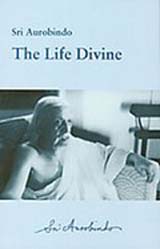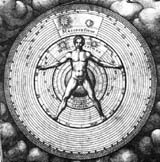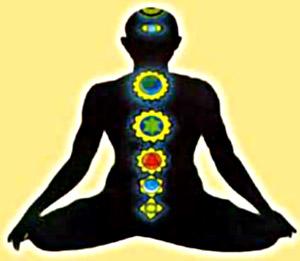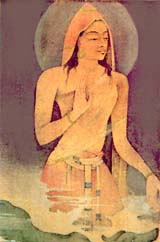Editorial
Metaphysics and health – evolution of the concept of Integral Health
Should metaphysics be related to health? It is justified to do so. Our world-view progresses from two directions. We can start from the ground reality, gathering scattered evidence, correlating multiple variables and methodically progressing, brick by brick, until a tsunami of fresh ideas usurps the logic construct to rebuild a new foundation. The passage is not smooth but that is how deductive knowledge progresses through trials and errors, constructing and deconstructing hypotheses based on mutable laws governing a flux of probabilities and possibilities.
The seers and mystics of India used a different approach by an experiential contact with a higher suprarational reality through an extension of the repertoire of consciousness. This inductive method led to the springing forth of intuitive seed-ideas that shaped civilisation at a time when science and technology had not developed to the extent we find today. Thus Rauwolfia Serpentina or Sarpagandha, which was intuitively prescribed by the ancient Indian yogis for schizophrenia, was the only pharmacologically correct drug for the disease till chlorpromazine was discovered in the middle of the twentieth century. Likewise, the description of the three types of fire in the Rig Veda correctly discriminated between ordinary fire, electricity and nuclear fission.
The Time-Spirit of today demands a synthesis of inductive and deductive knowledge, of Intuition and Reason, of Science and Mysticism, of Spirit and Matter. That is the message of Sri Aurobindo to the contemporary world; that is the Zeitgeist pressing beyond even what is fashionably called post-modernism. It is in this background that we shall attempt to understand the significance of certain seed-ideas in Sri Aurobindo’s The Life Divine in terms of health. Of course, these seed-ideas are universal truths that have survived the vicissitudes of time. In this article, we shall try to understand their relevance to health. The beauty of the seed-ideas is that they are simultaneously relevant to multiple spheres of life, multiple disciplines of knowledge.
The Life Divine starts with the observation that despite periods of scepticism and banishment and the satiation with benefits of materialism, the perennial quest for Wisdom gets rejuvenated again and again in the clarion call for ‘God, Light, Freedom, Immortality’. The human aspiration “manifests itself in the divination of Godhead, the impulse towards perfection, the search after pure Truth and unmixed Bliss, the sense of a secret immortality (1).” We shall try to understand how these seed-ideas, these eternal principles have ramifications in the field and matrix of health.
God
In Aurobindonian parlance, the term ‘God’ does not have an anthropometric value. It is rather a status of Consciousness that manifests in transcendental, universal and individual poises. It is simultaneously the essence of all forms, the matrix from where all forms arise and the transcendence of all forms. It is at once the Consciousness that is diffused in the universal poise beyond the constraints of space and time, the Consciousness that is concentrated in individual forms within the constraints of space and time, as well as the Consciousness that transcends the universal and individual beyond our cognitive appraisal. If that is so, then all existence is potentially divine. If there are anti-divine forces then they can also be transformed and transmuted into positive attributes. In other words, the microcosm is represented in the macrocosm and vice versa. The Higher Reality can manifest in the lower Reality and the lower reality can be transformed in terms of the Higher Reality.
Such a percept-construct of God has important ramifications in the paradigm of health:
(a) The fact that the Divine is the essence of all existence influences the very concept and definition of health. In the classical Indian tradition, there are two terms for health. One is aarogya, which is freedom from ailment. The other is svaasthya which means to be rooted in one’s ‘Self’. In other words, it means to be poised in one’s spiritual essence. Today the WHO definition of health acknowledges the physical, social, psychological and spiritual dimensions of health. Health is thus considered to be a multi-dimensional construct. But the moment it is accepted that health denotes a poise in one’s spiritual self, we move to an entirely new paradigm of health and well-being, which despite being multidimensional is simultaneously integrated around a deeper, beyond-ego principle. This is a poise which is pluri-dimensional and integral at the same time. This is the genesis of the concept of Integral Health where all the unique and distinctive dimensions of health are integrated in terms of consciousness around an inmost principle. Sri Aurobindo named this inmost, fourth dimensional principle the ‘Psychic Being’ which is actually a projection of the Atman or Soul in the manifestation and surpasses the ego.
(b) The concept that all existence is potentially divine gives an equal qualitative weightage to all forms of creation. Unlike other world-views where the human being is considered to be born to dominate all other forms in creation, the concept that the Divine is equally and wholly present in all created forms makes it obligatory to serve all human beings equally irrespective of all prejudices and preferences. Moreover this obligation extends to the protection and care of the health of all living and non-living forms on the planet. Thus the health of the animal and vegetable kingdoms is imperative as well as the concern for our ecological balance. In fact, the concern for our zoological, botanical and ecological health is not merely an extension of our social responsibility or expression of the psychological value of compassion but an inherent, unavoidable duty implicit in our divinity which we as human beings have the privilege to be ‘conscious’ of unlike other forms in creation.
(c) The element of divinity at the heart of each form is the immutable that supports the mutant variability of forms. In the human being, this inmost principle is represented in the Psychic Being that carries the quintessence of Integral Health. An individual may be terminally ill, demented or even comatose but the Psychic Being remains unaffected. Our service in terms of health is at the altar of this spiritual essence of the individual, the Godhead within, irrespective of one’s age, terminal status and level of cognitive awareness. Even a moment before one’s demise, one has the right to receive the fullest care and attention. Even a second before one’s departure from life, one has the right to receive new knowledge. If we take this attitude, then we shall have a new orientation in the care-giving and management of the aged, the terminally ill, the demented and the mentally challenged.
LightLight in Aurobindonian parlance is not a static source of illumination but knowledge in its dynamic mode. Knowledge cannot remain in a static mode; it needs to be effectuated in reality. It has to be synthesised with Energy or Will so that Knowledge becomes automatically effective and the Will becomes spontaneously luminous. Sri Aurobindo used the term Chit-Shakti to describe this complex of Knowledge-Will.
At a practical level, this combination of Knowledge and Will is very important in the sphere of health. On one hand, there are disciplines where scholars are content to endlessly speculate and theorise only at the level of ideas, constructing, deconstructing and reconstructing hypotheses — an absorbing and fulfilling brainstorming cognitive exercise. One can afford to indulge endlessly in such a knowledge-game to satiate the intellectual ego as long as one does not need to act out the ideas at a practical level. On the other hand, there are disciplines where action is imperative and has to be undertaken even if not backed by sufficiently strong theoretical foundation. However, the discipline of health is unique because at every level, the knowledge and action have to complement each other. If there is a theory to account for a particular pathology, the corresponding therapeutic intervention has to be simultaneously planned and executed to be of any value. In cases where the action is effective without an adequate theoretical explanation, scientists do not sit idle but go on exploring and testing multiple hypothetical possibilities. Such endeavour is necessary not as a mere intellectual indulgence but as a mandatory exercise. The discipline of health deals with life and death and medical knowledge has to be therapeutically effective and perfect within the constraints of space and time. Moreover, even if the theory is not fool-proof, the therapeutic action can still be successful if the doctor or healer has the correct intuitive knowledge coupled with the dynamism and confidence to execute it. This makes healing a challenging task. Thus the sphere of health is an ideal matrix for the synthesis of Knowledge and Will, a synthesis so eulogised in the Consciousness paradigm of Sri Aurobindo’s integral world-view.
FreedomUnlike the West, where the concept of freedom is primarily invested with a political connotation, the pristine tradition of India focused on the freedom of the soul from the attachments of life and from the cycle of birth and death. A yogi who achieved such a freedom was a Jiivanmukta and was free to participate in the world-play in a detached and non-judgmental way or else to abandon life and identify with the inaction of the Absolute. Sri Aurobindo gives a fresh connotation to the concept of freedom. He advocates a perfection of earthly life. This necessitates a poise of consciousness where one can free oneself from the chains of fate, the mechanical rigidities of physical nature, the lure of desires, the overvaluation of thoughts, the fixations of the ego, the pull of the inconscience so that one can achieve perfection without abandoning life. Such a concept elevates the vision of well-being and health. For long the freedom of the soul from life was given preference and the body was considered an obstacle to spiritual progress and perfection. But as Sri Aurobindo prefers perfection in earthly life, both the soul and the body require to be addressed with equal importance. This is why we need to construct a paradigm of Integral Health and Integral Well-Being. Sri Aurobindo explains the metapsychology of the integral world-view:
“The affirmation of a divine life upon earth and an immortal sense in mortal existence can have no base unless we recognise not only eternal Spirit as the inhabitant of this bodily mansion, the wearer of this mutable robe, but accept Matter of which it is made, as a fit and noble material out of which He weaves constantly His garbs, builds recurrently the unending series of His mansions (2).”
ImmortalityImmortality is a perennially intrinsic longing in human nature despite the limitation of life by death. Yudhishtira in the Mahaabhaarata considered this phenomenon to be the greatest paradox of life. But it is precisely for this psychological urge that medical science was geared to find out ways and means to reduce morbidity and postpone mortality. The yogic tradition in India focused on an extension of consciousness beyond the limitations of individual forms. Sri Aurobindo added another dimension. He also focused on the extension of consciousness beyond the limitations of the human species. The evolutionary chain produces myriad species but each species moves within fixed boundaries and functions in accordance to fixed typal settings. Sri Aurobindo intends to break the fixities of the human species through a conscious and accelerated evolution in consciousness. Immortality will get expressed through the manifestation of higher and higher models of the human being that would surpass the transitional form we inhabit today. The structure and functions of the bodily organs would transmute towards suppleness, flexibility, elasticity and luminosity in such a way that an individual ‘will’ could become the determinant of one’s own life-span. Sri Aurobindo’s futuristic vision holds great challenges in the spheres of life, health and human development.
References1. Sri Aurobindo. The Life Divine. Pondicherry; Sri Aurobindo Ashram Trust, 1970, p. 1.
2. Ibid. p. 6.
Share with us (Comments, contributions, opinions)
When reproducing this feature, please credit NAMAH, and give the byline. Please send us cuttings.





